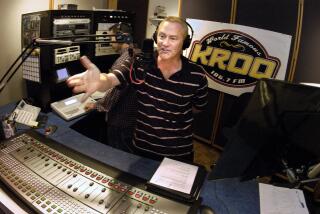KPWR WIELDS POWER IN RADIO RATINGS WAR
- Share via
Los Angeles radio is moving to the right--the far right of the dial.
According to the latest Arbitron radio survey, the real action is on the starboard side of your car radio. KROQ-FM (106.7)--just purchased for an astounding $45 million by Infinity Broadcasting--has moved up from a 3.9 to a 4.3 rating, making it easily the highest-rated album-rock station in the market. And in an even more spectacular ratings jump, KPWR-FM (105.9 and known as Power 106) has catapulted to a 4.4 rating, its highest ever and a leap of nearly 150% over its rating in the previous Arbitron survey released just three months ago.
The KROQ numbers are a pleasant surprise, especially for fans bored by the formula rock popular on album-rock rivals KLOS-FM and KMET-FM. But the Power 106 ratings, which make it second only to KIIS-FM among rock stations in the market, come as a real shock. It was only last January that the station, plagued by cellar-dwelling numbers, changed its call letters from KMGG (Magic 106) and shifted its format from soft rock to Big Beat dance music.
And new KPWR Program Director Jeff Wyatt, who says he’s “in ecstasy” over the ratings leap, figures the boom to continue. He’s set his sights on the kingpin of L.A. rock radio, KIIS-FM, which has ruled the market for the past 18 months.
“I wouldn’t have come all the way from Philadelphia if I didn’t think we could be No. 1 in the market,” said Wyatt, who recently engineered a similar ratings coup for WUSL-FM (Power 99), which had become Philadelphia’s top-rated urban contemporary station. “They do a great job over at KIIS, but I think Rick Dees is beginning to go south. His ratings are the lowest they’ve been in more than a year. I think we can be right up there with KIIS. In fact, I think we can hit a 10 in this market before we peak.”
According to insiders, KPWR’s immediate success is largely due to the fact that the station has carved a comfortable niche between Top 40-style stations like KIIS and black music outlets like KJLH. They also credit Wyatt with astute programming, which has seen the station mixing in KROQ-style British-beat records with more traditional black sounds. KPWR has not only broken a host of hot new dance records, but the station keeps listener interest high by playing customized “power mixes” of popular dance tracks.
“We’re programming a kind of music that hasn’t been heard in this market in a long time,” Wyatt said. “Good radio is really nothing more than having a sensitivity to what people want to hear. Every market has its peculiarities--in fact, there’s nothing like L.A. back East--and the only way to find out what’s going on is to go out there and feel it.
“My programming staff and I spend as many as three nights a week in the local clubs, talking to the club deejays and seeing how the audience reacts to new songs. If they go crazy over something, then you know you’re on to something.”
Wyatt freely admits that he’s more of an assimilator than an innovator: “We’re not into breaking a lot of new records unless that’s what the audience wants. We’re trying to reflect our listeners’ tastes, not necessarily educate them.”
With that in mind, Wyatt and his team--which includes Rick Cummings, programming vice president of KPWR and parent company Emmis Broadcasting, and Joel Salkowitz, the station’s production wizard who oversees the “power mixes”--keep a close eye on listener reaction, audience research and store sales reports.
Still, the station has not only jumped on such oddities as “Diggin’ Your Scene” by the Blow Monkees and “Running” by the Information Society, but also added album tracks, like “RSVP” by Five Star, that have never been released as singles.
“You can’t be successful and be ruled by the tenets of lazy broadcasting,” Wyatt said. “That’s why we go out to the clubs and see what’s happening. You have to be a people-watcher to be tuned into what people want.”
Wyatt laughed. “Being out in the clubs all night after running the station all day can be a grind. Sometimes I feel as if I’m waking up after I go to work.”
More to Read
The biggest entertainment stories
Get our big stories about Hollywood, film, television, music, arts, culture and more right in your inbox as soon as they publish.
You may occasionally receive promotional content from the Los Angeles Times.








